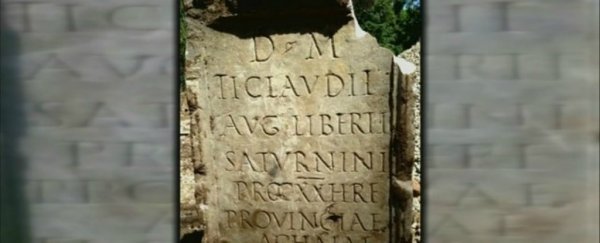Construction workers in Westchester County, New York were busy building multi-million dollar homes, when they made quite an unexpected discovery: an ancient Roman tombstone with Latin script on it that researchers say was crafted around 54 AD, nearly 2,000 years ago.
So what the heck is it doing in one of the wealthiest regions of New York?
For that answer, you need to first understand just how wealthy these folks in Westchester County have been over the years.
While you might not have heard of the area itself, you'll have definitely heard of the Gilded Age businessmen who lived there with their families, such as the Rockefellers, the Astors, and the Morgans.
This piece of land was even called Millionaires Row back in the late 19th century, because so many of the world's richest people lived there - a tradition that is actually still going on today.
This might not seem to have anything to do with ancient Romans, but back in the day of gilded tycoons, wealth was most conspicuously marked by two things: having castles built for you, and filling those castles with interesting things.
According to Kerry Drew at Fox5, the development site where the tombstone was found is named Greystone-on-Hudson, after Greystone Castle - the former mansion of Josiah Macy, John Rockefeller's Standard Oil partner.
After Macy died in the late 1800s, his wife continued to the live in the house. In 1893, she reportedly made a trip to the Villa Borghese in Rome, where she bought a monument and had it shipped back to the estate.
Nearly a century later, Greystone Castle burned down and the workers buried the wreckage. The site has remained untouched since, until the recent development started.
After the tombstone was found, researchers from the Metropolitan Museum of Art were called in to analyse the find.
Upon inspection, they determined the stone was crafted around 54 AD, saying that the Latin inscription indicates that it once "belonged to a tax collector named Tiberius Claudius Saturninus", Sarah Laskow reports for Atlas Obscura.
Experts think that Saturninus was a freed man who served as a tax collector under Emperor Claudius during his reign, making the tombstone even more historically valuable.
Stories of construction workers uncovering remarkably old and mysterious treasures have been popping up all over the place lately.
Just a few days ago, archaeologists in Mexico City identified a large, oval-shaped platform that was first discovered by construction workers back in 2014 as a 650-year-old temple to the Aztec wind god Ehecatl-Quetzalcoatl.
If you want to see the recently rediscovered tombstone for yourself, it's currently on display at the Metropolitan Museum of Art in the Greek and Roman Galleries.
